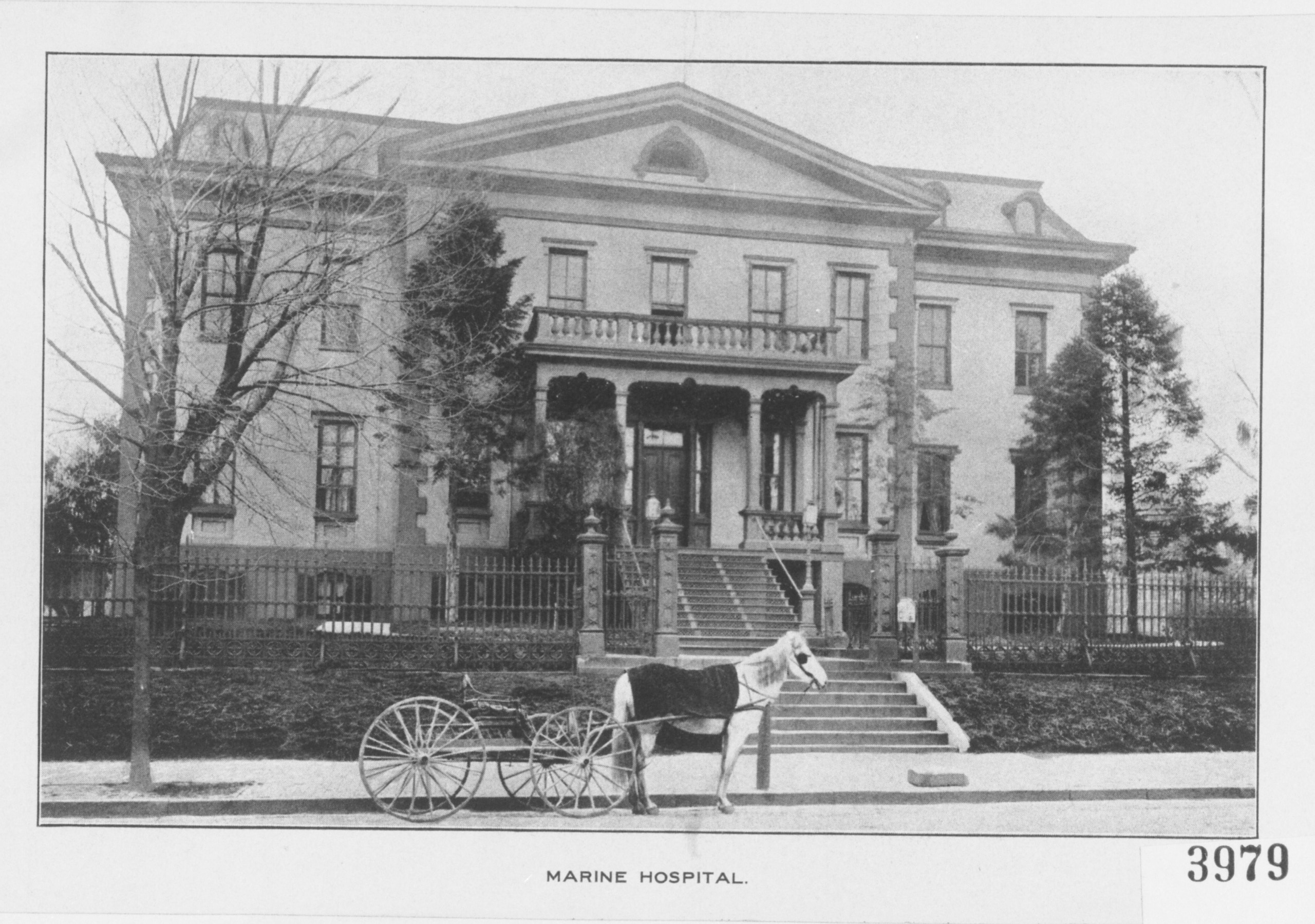
In part 1 of this story, I explored the history of the Cottage veranda and its connection to the veranda at the Old Naval Hospital. In this issue I will discuss the upcoming work on the Cottage veranda, and my return to the Old Naval Hospital (ONH) to see how its veranda has fared since it was restored in 2006. I will also explore some of the maintenance challenges and solutions that ONH, or any organization, may face when stewarding an historic building.
-
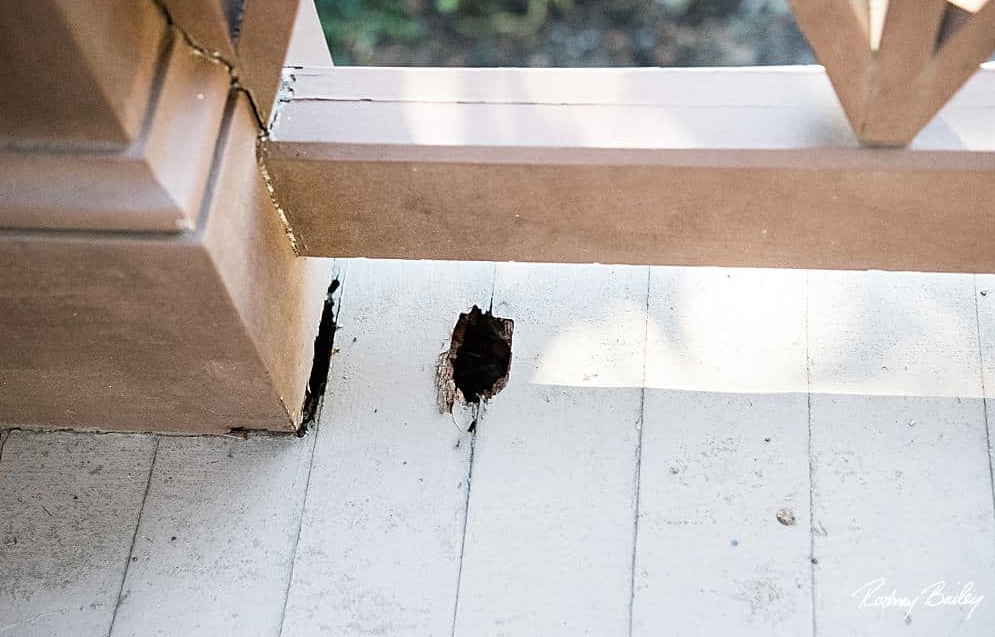
The first area of damage with the paint removed
And there it was. A little depression on the veranda floorboard about the size and shape of a Chesapeake Bay oyster.
“Oh that’s not good,” I thought. I had seen this before at the Cottage and it resulted in a total restoration of the west balcony. The recognizable depression on the floorboard was caused by the wood rotting away and the only thing hiding the deteriorated wood was a thin layer of beige paint.
Sometimes this type of deterioration is focused on one small area. It can be caused by a slight dip that catches water or plants growing on or too close to the building. And sometimes its systemic. I once used reclaimed red oak flooring on the screened-in porch of my Baltimore rowhouse.
I knew better, but it was inexpensive, and the little preservation devil perched on my shoulder had whispered, “Oh shush, it will be fine. Oak is really durable.”
The little preservation nerd on my other shoulder pushed up his cracked safety glasses and replied, “Um, well, red oak is actually very porous, and the end grain will suck up water faster than cotton socks in an old pair of shoes.”
“Oh pashaw”, the little preservation devil purred. “It will hardly ever get wet. Just paint the end grain. It will be fine.”
Three years later I had an entire colony of little Chesapeake Bay oyster depressions on my porch.

Line of damage beneath lower rail
Upon further inspection it became clear that the damage to the Cottage veranda flooring was not limited to the one area and was not systemic. Rather, it manifested in a pattern that ran directly beneath the lower rail of the east balustrade.

Temporary roof supports in place
How did this happen? There are no low areas to catch water and plants are always kept at least one foot away from the building. The flooring, installed in 2005, is mahogany; a lumber typically well suited for this application. Additional probes revealed that the deterioration had descended through the flooring and caused significant damage to the double joist that spanned the brick piers.

Deteriorated joist
What started as a perceived minor repair had expanded to a full 1/3 of the veranda! The decision was made to remove all the flooring so the remaining joists could be inspected and hopefully gain some insight into why the deterioration occurred. But before I began the Cottage project, I wanted to return to the ONH veranda and see how it had fared since completing the restoration in late 2006.
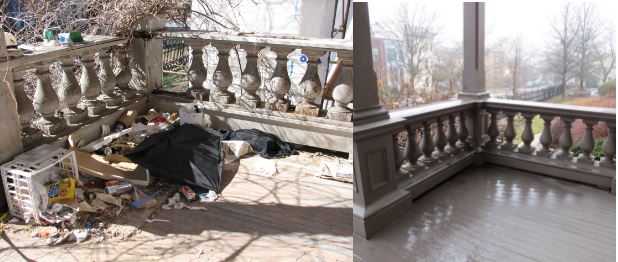
The ONH veranda prior to restoration in early 2006 and in February of 2022
It can be insightful to revisit one’s old projects, but I had no idea how it was going to look and the memories from that time had begun to roll in. It was my first big DC based project working with an architect and the city (oh my gosh, so much paperwork). I recalled my first site visit in April and though I hadn’t even been offered the job I knew I wanted it and was already plotting the way forward. The project had all the challenges one would expect; supporting a porch roof, lead paint, change orders and deadlines.
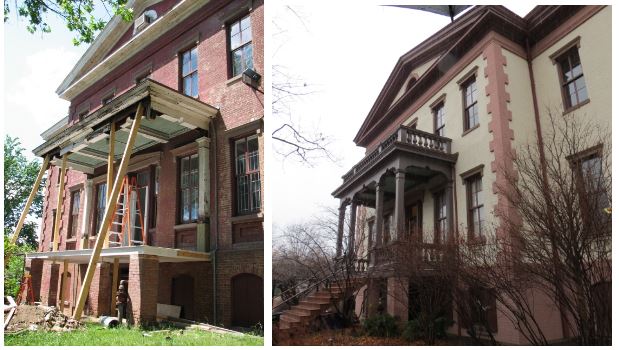
Roof supports in place in 2006 and how it looks today
And there was the time, after I had removed the temporary roof support but had not yet removed the stakes that had held the supports in place, that another contractor on the site hammered the stakes into the ground. Right through the gas line.
In the end it was a lot of fun (even if I only made about $2.54/hour) and I think we did something of value that became a small part of a larger project to create what is today The Hill Center, a non profit that “aims to broaden the horizons of all who enter by providing high-quality arts, education and cultural programs and other opportunities to engage more fully in the life of our city.” (Hillcenterdc.org)

2006 restoration in progress
So how did the veranda look on my first visit to ONH in over fifteen years?? What follows is not a disparagement upon the good folks that maintain the ONH but rather an acknowledgment that resources are often scarce, and one does the best they can with what they have and perhaps my observations can assist them as they continue their stewardship of the veranda.
What is the primary cause of deterioration in an old building? When asking the question to visitors on my preservation tours I usually respond quickly by saying, “children” (I can say that because I have two children). The real answer is water. This is followed, in no particular order, by neglect, fire, insects, and the actions of inexperienced and thoughtless contractors (oh boy, I could fill a book or two with that one).
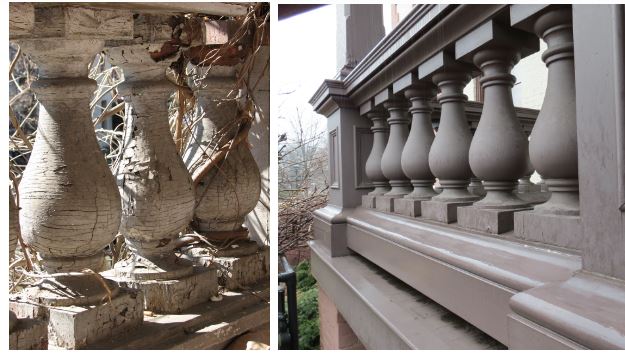
Damaged balusters prior to 2006 restoration and as they look now (note early signs of deterioration at base)
Water always finds a way but there are ways to mitigate its presence by taking steps to get the water away from the building. This can be a complicated endeavor especially when dealing with groundwater but for the purposes of this conversation let’s keep it simple with these three actions:
- The installation of gutters and downspouts. The veranda at ONH has what appears to be a properly functioning built-in gutter and downspout system but it is important that it is checked at least twice a year to ensure the downspouts are not blocked with leaves and other debris.
- Ensure building components are pitched to shed water. The ONH veranda was designed so all components are properly pitched but it is good practice to occasionally grab an umbrella and channel your inner Gene Kelly while watching where the water goes during a heavy rain. (singing is optional)
- Develop and follow a thorough maintenance plan. The development of a thorough maintenance plan is an invaluable endeavor that helps one understand the various components of a building and their unique needs. However, it’s just words on paper if the plan is not followed. A good plan should include an annual inspection of wooden components for signs of paint failure, deteriorated wood and open joints. The plan should also include solutions for dealing with all those issues before the problem is exacerbated.
There are numerous areas on the ONH veranda showing signs of paint failure, minor wood deterioration and open joints that could be addressed with minimal maintenance and two larger areas of concern on the southwest corner and at the top of the stairs.
In next month’s newsletter, I will complete the veranda trilogy by looking deeper into the causes of deterioration on both verandas and discuss possible solutions!
